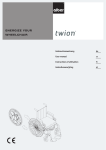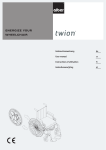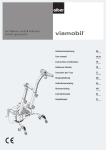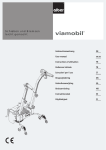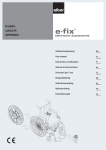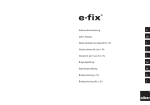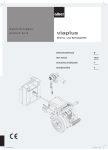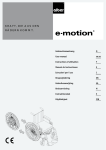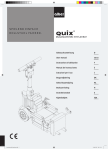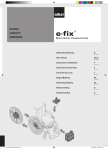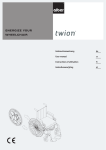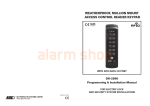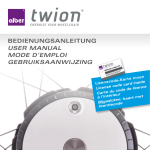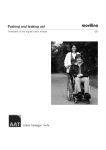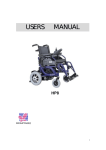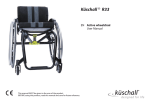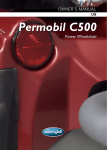Download Alber Twion User Manual
Transcript
Gebrauchsanweisungde User manual en Instructions d’utilisation fr Gebruiksaanwijzingnl Service Center (Deutschland) Montag bis Donnerstag von 8.00 - 18.00 Uhr Freitags von 8.00 - 16.00 Uhr erreichbar unter Telefon (0800) 9096-250 (gebührenfrei) USA and CANADA only ! CAUTION Federal law restricts this device to sale by or on the order of a practitioner licensed by the law of the State in which he/she practices. Powered Wheelchair Electromagnetic Interferences (EMI) Because EM energy rapidly becomes more intense as one moves closer to the transmitting antenna (source), the EM fields from hand-held radio wave sources (transceivers) are of special concern. It is possible to unintentionally bring high levels of EM energy very close to the powered wheelchair’s control system while using these devices. This can affect powered wheelchair movement and braking. Therefore, the warnings listed below are recommended to prevent possible interference with the control system of the powered wheelchair. ! WARNING Radio wave sources may affect powered wheelchair control Electromagnetic interference (EMI) from sources such as radio and TV stations, amateur radio (HAM) transmitters, two-way radios, and cellular phones can affect powered wheelchairs and motorized scooters. Following the warnings listed below should reduce the chance of unintended brake release or powered wheelchair movement which could result in serious injury. 1) Do not operate hand-held transceivers (transmitters-receivers), such as citizens band (CB) radios, or turn ON personal communication devices, such as cellular phones, while the powered wheelchair is turned ON; 2) Be aware of nearby transmitters, such as radio or TV stations, and try to avoid coming close to them; 3) If unintended movement or brake release occurs, turn the powered wheelchair OFF as soon as it is safe; 4) Be aware that adding accessories or components, or modifying the powered wheelchair, may make it more susceptible to interference from radio wave sources. (Note: There is no easy way to evaluate their effect on the overall immunity of the powered wheelchair); and 5) Report all incidents of unintended movement or brake release to the powered wheelchair manufacturer, and note whether there is a radio wave source nearby. Important Information 20 volts per meter (V/m) is a generally achievable and useful immunity level against EMI (as of May 1994) (the higher the level, the greater the protection). All alber power-drives have an immunity level of 20 V/m; adventure has an immunity level of even 30 V/m. ! CAUTION IT IS VERY IMPORTANT THAT YOU READ THIS INFORMATION REGARDING THE POSSIBLE EFFECTS OF ELECTRO-MAGNETIC INTERFERENCE ON YOUR POWERED WHEELCHAIR. Electromagnetic Interference (EMI) From Radio Wave Sources Powered wheelchairs and motorized scooters (in this text, both will be referred to as powered wheelchairs) may be susceptible to electromagnetic interference (EMI), which is interfering electromagnetic energie (EM) emitted from sources such as radio stations, TV stations, amateur radio (HAM) transmitters, two-way radios, and cellular phones. The interference (from radio wave sources) can cause the powered wheelchair to release its brakes, move by itself, or move in unintended directions. It can also permanently damage the powered wheelchair’s control system. The intensity of the interfering EM energy can be measured in volts per meter (V/m). Each powered wheelchair can resist EMI up to a certain intensity. This is called its “immunity level”. The higher the immunity level, the greater the protection. There are a number of sources of relatively intense electromagnetic fields in the everyday environment. Some of these sources are obvious and easy to avoid. Others are not apparent and exposure is unavoidable. However, we believe that by following the warnings listed below, your risk to EMI will be minimized. The sources of radiated EMI can be broadly classified into three types: 1) Hand-held portable transceivers (transmitters-receivers) with the antenna, mounted directly on the transmitting unit. Examples include: citizens band (CB) radios, “walkie talkie”, security, fire and police transceivers, cellular telephones, and other personal communication devices. Note: Some cellular telephones and similar devices transmit signals while they are ON, even when not being used; 2) Medium-range mobile transceivers, such as those used in police cars, fire trucks, ambulances, and taxis. These usually have the antenna mounted on the outside of the vehicle; and 3) Long-range transmitters and transceivers, such as commercial broadcast transmitters (radio and TV broadcast antenna towers) and amateur (HAM) radios. Note: Other types of hand-held devices, sich as cordless phones, laptop computers, AM/FM radios, TV sets, CD players, and cassette players, and small appliances, such as electric shavers and hair dryers, so far as we know, are not likely to cause EMI problems to your powered wheelchair. Table of Contents 1. Introduction 1.1 Important safety notes – please observe carefully at all times 1.2 Proper use of the twion 1.3 Permissible conditions of use/locations of operation 1.4 Standard scope of delivery 1.5 Optional accessories 1.6 The main elements at a glance 2. Starting up 2.1 Installing the wheels 2.2 Switching on the wheels at the wheel hub 2.3 Switching the wheels off 2.4 Removing the wheels 2.5 Transporting and storing the wheels as vehicle luggage 3. Safety instructions and hazard information on driving with the twion 3.1 General information 3.2 Safety instructions 3.3 Obstacles 3.4 Danger areas and hazardous situations 4. Battery (in-built in the wheels) 4.1 Safety instructions for the batteries installed in the twion wheels 4.2 Storing the wheels 4.3 General information on charging the batteries 4.4 Safety instructions for the battery charger and the charging process 4.5 Charging process 5. Displays and fault indications on the wheel 5.1 The charge status of the battery 5.2 Displays when charging the battery 5.3 Fault indications 5.3.1 Fault indication of the battery 5.3.2 Fault indications when charging the batteries 5.3.3 Fault indication of the push rims 5.3.4 Fault indication in the event of excessive temperatures 5.3.5 General faults 6. Automatic shut-down 7. Replacing the fuse 8. Anti-tippers (optional accessories) 8.1 Fitting and removing Alber anti-tippers 8.2 Using the Alber anti-tippers 8.3 Important operating and safety instructions 9. Care, safety inspections (maintenance) and disposal 9.1 Care 9.2 Re-use 9.3 Maintenance (safety inspections) 9.4 Disposal 10. Warranty, guarantee and liability 10.1 Warranty for defects 10.2 Guarantee of durability 10.3 Liability 11. Technical data 12. Labels and explanation of symbols 33.0001.4.99.02 As of: 2015-07-14 2 2 2 3 3 3 4 5 6 7 7 8 9 10 10 11 12 12 13 13 13 13 14 15 16 16 17 18 18 18 18 19 19 19 19 20 20 21 22 23 23 23 23 23 24 24 24 24 25 26 1 1. Introduction 1.1 Important safety notes – please observe carefully at all times The twion is an add-on drive for wheelchairs. For safety reasons, it must only be operated by persons who •• have been instructed in its handling, •• can move and coordinate both hands or arms without major restrictions, •• have the physical and mental ability to safely operate the wheelchair with the twion wheels attached to it in all possible situations and in the event of the twion wheels failing to work, the user is able to brake the wheelchair and stop safely. A one-to-one instruction session on handling and operating the device is included in the scope of delivery. Please contact your specialist dealer or Alber GmbH agent to arrange for a training session. The instruction is free of charge. If you feel a little unsure about how to handle your twion please contact your specialist dealer for advice. In the event of technical faults, please contact your specialist dealer or the Alber Service Center (Tel: 0800 9096 250). When operating the twion, observe the specifications of the wheelchair manufacturer (e.g. maximum slope, air pressure of tyres etc.), and strictly adhere to the operating instructions of the wheelchair. Never exceed any of the specified limit values. 2 We recommend refraining from using the twion in locations that are exposed to strong electric fields. In rare cases, the operation of the twion may interfere with other electrical devices such as anti-shoplifting barriers in department stores. You must not use the twion on escalators or moving walkways. Similarly, combining the twion with accessories that have not been approved by Alber is also prohibited. ! Therefore, do not start using the twion before you have been properly instructed in its operation by an authorised specialist dealer or an agent of Alber GmbH. 1.2 Proper use of the twion Wheelchairs that are fitted with twion wheels are designed exclusively for transporting persons with a walking disability. Do not attach any parts other than the accessories that have been approved for use by Alber. Equally, the device must not be technically modified. The twion must only be operated under the following conditions: •• Full compliance with the information, instructions and recommendations contained in this operating manual •• The device is only operated by a person who has been instructed in its use •• No technical modifications have been made to the device by the user or by any third party An instructed person is a person who has been instructed in the operation of the twion and in his/her tasks and who has been made aware of the possible hazards associated with improper use of the device. In general, this is the user of the wheelchair to which the twion wheels have been fitted. The instruction session is provided by the authorised specialist dealer or by an agent of Alber GmbH. It is strictly prohibited for any uninstructed or unqualified persons to use the twion. The twion must not be used for any purpose that contravenes the intended use of the device. This particularly applies to all types of load transports such as the transporting of household objects or additional people. Proper use includes complying with the information specified in this manual on carrying out safety checks and observing and adhering to the safety precautions and hazard warnings for driving. The use of the twion for any of the following purposes is deemed to be misuse by Alber GmbH: •• Use or operation of the device that contravenes the instructions and recommendations in this operating manual. •• Exceeding the technical limits laid down in this operating manual. •• Technical modifications to the device. •• Attachment and/or use of parts and accessories that have not been supplied or approved by Alber GmbH. Damage resulting from •• using the device improperly, •• use by a person who has not been instructed in the handling of the device •• use that contravenes the instructions and recommendations in this operating manual •• exceeding the technical limits laid down in this operating manual shall not be deemed by Alber GmbH as part of the company’s liability. ! Before using the twion, carefully read all safety and hazard information contained in the individual chapters of this operating manual. 1.3 Permissible conditions of use/locations of operation •• Observe the permissible conditions of use of the wheelchair to which the twion wheels are attached (see wheelchair manual). •• In addition to observing the information provided on the twion it is also imperative to observe the information provided by the wheelchair manufacturer (e.g. maximum climbing capacity, maximum permissible height of obstacles, maximum user weight, maximum speed etc.). The lowest values always apply. •• The twion must only be used at temperatures between -25°C and +50°C. Therefore, do not expose the twion to any heat sources (such as intense sunlight) as this may cause surfaces to reach high temperatures. •• Avoid using the wheelchair on soft ground (e.g. loose chipping, sand, mud, snow, ice or deep puddles). •• Always observe the safety instructions and precautions from chapter 3. ! When not in use, do not expose your twion to strong sunlight for long periods of time. This could cause the motor to heat up and in an extreme case, not be able to operate at full power. Even plastic parts age quicker under intense sunlight. 1.4 Standard scope of delivery •• Two twion wheels •• A battery charger •• Operating manual The wheelchair must have special brackets to attach the twion wheels. If it does not, please contact your specialist dealer or an Alber representative. 1.5 Optional accessories – Anti-tippers for your wheelchair – Mobility Plus package We recommend using only original accessories supplied by Alber GmbH. The twion is designed in such a way that it performs best when using Alber original accessories. Alber GmbH shall not be liable for damage to the product or accidents (e.g. fire due to explosion of the battery, leaks etc.) caused by a malfunction of non-original accessories or spare parts. The warranty does not cover repairs for damage caused by malfunction of non-original accessories. Alber GmbH will, however, carry out such repairs for you at a charge. 3 1.6 The main elements at a glance (please fold out overview drawing in document cover) Wheel LED displays On/off switch with charger socket Stub axle locking mechanism Push rims Fins (rear of wheel) Stub axle 1 2 3 4 5 6 Wheelchair (not included in the scope of delivery) Bracket with wheel receiver 7 Wheelchair hand brake 8 Automatic charger Charging plug LED display Automatic charger housing 4 9 10 11 Anti-tippers (optional) Bracket12 Quickpin13 Clamping piece for anti-tipper 14 Holding rod 15 Bracket mounting fork 16 7 2. Starting up The twion wheels and any accessories you ordered will be fitted to your wheelchair by Alber or your specialist dealer and delivered so that they are ready for operation. Therefore, on both sides of your wheelchair there are new brackets [7] with wheel receivers for the two twion wheels to be inserted (see chapter 2.1). Please keep the manual wheelchair wheels you have used until now so that they can be used again if needed. On delivery of your twion your specialist dealer will show you how to operate the system and any accessories you ordered. You will also be given this operating manual which, in addition to the technical information, also contains important driving instructions. ! The brackets [7] must be attached to the wheelchair by Alber GmbH or its authorised specialist dealers. ! Regularly check the brackets [7] to ensure that they are firmly secured to the wheelchair. If a screw connection has become loose, contact your authorised specialist dealer to have it retightened. ! Alber GmbH provides brackets of various design (single-part or multiple-part brackets). The bracket shown in the diagrams of this operating manual may, therefore, deviate from that attached to your wheelchair. 5 2.1 Installing the wheels From a technical point of view, the stub axles [6] of the twion wheels are similar to the stub axles of your usual manual wheelchair wheels. In this respect you can attach the twion wheels to your wheelchair in the usual way. 5 •• Switch off the twion wheels before attaching them to the wheelchair (see chapter 2.3). •• Press the locking mechanism [3] at the centre of the wheel hub and at the same time push the stub axle [6] of the twion wheel into the wheel receiver [7] on the wheelchair. •• You might need to rotate the twion wheel a few millimetres around its axle so that the fins [5] located on the rear of the wheel click into place in the wheel receiver [7]. •• Check whether the twion wheel can be pulled out of the wheel receiver [7] without pressing the locking mechanism [3]. If so, the twion wheel is not sitting correctly in the wheel receiver [7] and needs to be inserted again as described previously. •• Attach the second twion wheel on the other side of the wheelchair. In these few steps, you have attached the twion wheels to your wheelchair. 6 6 7 ! The twion wheels must be switched off before attaching them to the wheelchair. ! Driving is only permitted with twion wheels that are correctly engaged in the wheel receiver [7]. ! Before every trip, check that your wheelchair brakes [8] are working correctly. These need to be correctly adjusted to the twion wheels and be able to prevent the wheelchair inadvertently rolling away at any time. 2.2 Switching on the wheels at the wheel hub If the two twion wheels have been correctly attached to your wheelchair as described in chapter 2.1, you can now switch on the system. •• Press the on/off button [2] on the wheel hub for about one second until you feel the limit. •• To confirm activation, an acoustic signal (1 beep) sounds on each wheel. •• All five LEDs [1] briefly illuminate and then convert to display status to show the battery’s charge status (see chapter 5.1). •• After about 2 to 3 seconds, the wheel is ready for use and you can begin your journey. Please observe the information from chapter 3. Note If the switched-on wheels are not used, they will automatically switch off after 15 minutes (see chapter 6 for more information). ! If a fault occurs when switching on the wheels, this is shown by the LED display [1] and acoustic signals (see also chapter 5.3.2). ! The two twion wheels are switched on one after the other, not at the same time. If they are activated at the same time, any warning signals (see chapter 5.3) may not be heard or assigned to the wrong wheel in error. 7 2.3 Switching the wheels off When you have finished your journey, the two twion wheels should always be switched off and the parking brakes on the wheelchair used. This not only saves the energy of the two batteries but also prevents your wheelchair potentially rolling away inadvertently. •• Press the on/off button [2] on the wheel hub for about one second until you feel the limit. •• To confirm deactivation, an acoustic signal (1 beep) sounds on each wheel. •• The LED display [1] of the wheels goes out. •• Secure your wheelchair against inadvertently rolling away by activating the wheelchair brakes. ! The twion wheels do not have any in-built brakes. It is therefore imperative to adjust the brakes fitted to your wheelchair to the twion wheels, to be able to secure your wheelchair from inadvertently rolling away. Please contact your specialist dealer in this regard. 2.4 Removing the wheels Generally, the twion wheels will remain on your wheelchair. If they need to be removed (for example, for transport purposes), please proceed as follows: •• Switch the twion wheels off if you have not already done so (see chapter 2.3). •• When using Alber anti-tippers: raise your wheelchair as described in chapter 8.2, and activate the anti-tippers. •• Press the locking mechanism [3] located at the centre of the wheel hub and carefully pull the twion wheel off of the wheelchair. •• Once both wheels have been removed you can replace the anti-tippers to their original position, as described in chapter 8.2. •• Without Alber anti-tippers: lift your wheelchair by its push handles. •• Press the locking mechanism [3] located at the centre of the wheel hub and carefully pull the twion wheel off of the wheelchair. 8 ! When removing a twion wheel never pull on its push rim [4]. This could damage the fitted sensors. Instead, hold the twion wheel by its tyre or the wheel hub when removing. Detaching the stub axle (if necessary) If the twion wheels are stored laying on their rear side, the stub axles [6] protrude above the wheel hub by a few centimetres. We therefore recommend taking the stub axles out of the wheel entirely, to prevent any possible damage. •• Hold the stub axle [6] between your index and middle finger as shown in the diagram, and press the locking mechanism [3] with your thumb. •• Pull the stub axle [6] out of the wheel hub and put it down. Inserting the stub axle If the stub axles have been taken out of the wheel as described above, they need to be reinserted in the wheel hubs before you next attach wheels to your wheelchair. •• Hold the stub axle [6] between your index and middle finger as shown in the diagram, and press the locking mechanism [3] with your thumb. •• Insert the stub axle [6] into the wheel hub. ! Only insert the supplied stub axles into the twion wheels. Do not use the stub axles of the manual wheelchair wheels because when used with the twion wheels these do not have the necessary length to ensure a secure fit in the brackets [7]. 4 2.5 Transporting and storing the wheels as vehicle luggage •• The twion wheels must be switched off before removing them from the wheelchair. •• If the twion wheels are taken off of the wheelchair, they must not be lifted or carried by the push rims [4]. This could damage the fitted sensors. Instead, carry the twion wheel by its rim. At this point there is no danger of damaging the wheel. •• When laying the wheel down or setting it aside, take care of the fins [5] and the stub axle [6] on the rear of the wheel. Neither part should be damaged. •• To transport the wheelchair, follow the instructions of the wheelchair manufacturer. You might need to secure the wheelchair or certain components. •• We recommend always removing the twion wheels from the wheelchair and transporting them individually. In doing so, the stub axle [6] should be removed entirely from the wheels. •• The wheels should be stored or transported on their rear side or standing up. •• During transport, the wheels must be properly secured so that they do not pose a risk to the driver or passengers in the event of a sudden brake manoeuvre. To secure the wheels we recommend securing them in the vehicle with sufficiently robust straps as shown in the diagram. Please note that this is a non-binding recommendation (we accept no liability). ! Do not attach the straps to the push rims [4] because this could damage their sensors. •• Please check whether there are specific regulations regarding the securing of wheelchairs and wheels for transport in your jurisdiction and strictly adhere to these regulations. •• Alber GmbH and its agents shall not be liable for any damage resulting from non-compliance with these instructions. •• If you wish to transport your wheelchair in its entirety, without dismantling the wheels, the wheelchair must be protected in accordance with the guidelines or specifications of the wheelchair manufacturer. The adjacent diagram is just an example. ! The use of the wheelchair with attached twion wheels as a vehicle seat is not permitted. 9 4 3. Safety instructions and hazard information on driving with the twion 3.1 General information Using the twion wheels is much the same as using the manual wheels you have been using. This means that you can move your wheelchair as normal with the push rims [4]. While the twion is switched on, each actuation of the push rims is converted into a drive command. The twion thereby supports both forwards and reverse movement and when accelerating and braking. It is therefore recommended that you have a short driver training session when you first receive your twion. This enables you to become familiar with the drive and all its possibilities. The twion wheels could also be used as manual push rim wheels when switched off. Only the additional weight of the wheels needs to be considered when starting off and braking. 8 Check that the hand brake [8] of your wheelchair has been adjusted to the twion wheels and therefore inadvertent rolling away is prevented. If this is not the case, please contact your Alber authorised specialist dealer and have the brakes readjusted. 10 Information on driving training •• Start your first driving attempts with caution and start your driving training on level ground. •• Take your driver training in areas without obstacles. •• Before using the twion to drive up or down a slope, practice operating the device on level ground. •• Always adapt your speed to external conditions to be able, for example, to drive around any obstacles that suddenly appear or to stop your wheelchair. •• Always drive up slopes with a fully charged battery. If the battery is empty the wheels will continue to work, however, the rolling motion and especially the braking process is no longer supported! •• When travelling down slopes of any kind, special caution should be exercised. If driving down slopes with a fully charged battery and at high speed, this can lead to the twion being forced to shut down due to overvoltage. The wheels continue to work but there is no longer any power support for braking. Therefore, drive down slopes at slow speed. This is advisable in any case to avoid any obstacles that suddenly appear or to stop the wheelchair. •• Observe the information, safety instructions and hazard information of your wheelchair manufacturer. This also applies to driving with the twion. ! Exercise caution when travelling downhill with a fully charged battery. A fully charged battery and high speeds may lead to the system automatically switching off. Therefore, reduce your speed. ! As far as possible, negotiate obstacles (e.g. kerbs) in reverse. The maximum permitted obstacle height is 50 mm. Caution: when negotiating obstacles in reverse, the Alber anti-tippers cannot be guaranteed to be fully functional. For this reason, drive slowly and carefully in reverse until the wheels of your twion touch the obstacle. Now carefully negotiate the obstacle. It is up to you to decide whether to enlist the help of another person. ! Observe the following safety instructions and hazard information. ! Immediately contact your specialist dealer in the event of a breakdown. 3.2 Safety instructions •• The twion wheels must be switched off before being attached to the wheelchair, when removing them from the wheelchair and before starting work on the wheelchair or directly on the wheels. •• For safety reasons you need to activate the parking brakes of your wheelchair, especially on uphill and downhill slopes, to avoid the wheelchair inadvertently rolling away. •• In the (unlikely) event of the battery overheating or catching on fire, you must ensure that the battery does not come into contact with water or other liquids. The only suitable extinguishing agent that is recommended by the battery manufacturers is sand. Before using the device: •• The twion must only be attached to push rim wheelchairs that have been approved by Alber GmbH for this device. •• The bracket holding the twion in place may only be installed and modified by Alber GmbH or an Alber authorised specialist dealer. •• When using the twion, always strictly adhere to the operating instructions of the wheelchair. •• Driving the wheelchair without an attached pair of anti-tippers is not permitted. •• Attach the original anti-tippers of the wheelchair manufacturer or the optional Alber anti-tippers to your wheelchair. •• Before every journey, check the twion wheels. If the tyres have reached their wear limit (you can no longer see the tread), the twion must not be used. •• Before every journey, check that your wheelchair parking brakes are working correctly. You cannot drive the wheelchair without your parking brakes working correctly. •• Check the air pressure of the twion wheels at regular intervals. For details on the correct air pressure, see the outside of the tyres and the table in chapter 11. Please check the air pressure of the front wheels in accordance with the instructions and specifications of the wheelchair manufacturer. Too low an air pressure can greatly affect the driving behaviour and the range. •• Both twion wheels should always have the same air pressure. •• Both front wheels of the wheelchair should always have the same air pressure. •• Before every journey, check the correct fitting of the twion wheels in the two wheel receivers of your wheelchair. •• The twion must not be used in combination with a wheelchair puller or hand bike. Even if the twion drives are switched off, there is a risk of the electronic system sustaining damage from the current induced by the fast rotation of the wheel. When using the twion, observe the following: •• Before using the twion to drive up or down a slope, practice operating the device on level ground. •• The maximum permissible slope specified by the wheelchair manufacturer must not be exceeded. •• Approach steps or drops extremely cautiously. •• While the twion is switched on, each actuation of the push rims is converted into a drive command. When stopping or waiting in potentially dangerous positions (e.g. while waiting at a traffic light, on uphill and downhill slopes or ramps of any type), do not touch the push rims and secure your wheelchair using its parking brakes. •• Never reach into the wheel when the twion is switched on. •• Do not insert or throw objects of any kind into a switched on or off twion wheel. •• Never attach objects of any kind to the push rims. These could induce involuntary drive impulses. •• When driving on pavements, keep a safe distance (preferably the width of the wheelchair) from the kerb. •• Avoid using the wheelchair on soft ground (e.g. loose chipping, sand, mud, snow, ice or deep puddles). •• Never leave the twion unattended, even if it is switched off. •• The twion may be adversely affected by strong electromagnetic fields, particularly in the vicinity of the push rim sensor. •• Conversely, the twion may interfere with other electrical equipment such as anti-shoplifting barriers in department stores. •• You must not use the twion on escalators or moving walkways. •• When travelling, do not suddenly change the direction of travel to left or right at maximum speed as this could cause the wheelchair to tip sideways. •• Reduce your speed when going round a corner. •• If you intend to stop in your wheelchair on an uphill or downhill slope, your wheelchair must be parked across this slope and the parking brakes activated. •• After every trip or when your wheelchair is idle, activate the parking brakes to prevent the chair inadvertently rolling away. •• Do not travel across downhill slopes. •• Do not reach into the spokes of the twion wheels when travelling, or into the front wheels of your wheelchair. •• Apply your twion brake carefully and adapt your speed accordingly (i.e. not suddenly). •• When travelling in a vehicle, only sit in the vehicle’s installed seats with associated restraint systems. Not complying with this guideline runs the risk of you and your co-passengers being injured in an accident. •• When travelling by vehicle, secure your wheelchair and the twion wheels according to the current applicable statutory requirements and legislation. •• When travelling on public roads and pavements in the Federal Republic of Germany, the provisions of the German Road Traffic Regula- 11 tions and the Road Traffic Licensing Regulation must be observed. In other countries, the national provisions applicable there must be observed. •• The twion is only intended for transporting persons with restricted mobility and must not be misused, for example by children playing with it or to transport goods. •• Operating the twion in the vicinity of strong magnet fields such as those induced by holding solenoids, transformers, tomographs etc. is prohibited. •• Avoid travelling using the twion in adverse conditions, for example in storms, hail and in high undergrowth. After using the twion, observe the following: •• When not in use, the twion must be switched off to prevent inadvertently triggering of drive pulses when the push rims are touched and to prevent the battery from discharging completely. •• Whenever the wheelchair is idle, activate the parking brakes. •• Recharge the battery of your twion as soon as possible after each trip. 12 3.3 Obstacles As far as possible, only negotiate obstacles (e.g. kerbs) in reverse. The maximum permitted obstacle height is 50 mm. Caution: when negotiating obstacles in reverse, the Alber anti-tippers cannot be guaranteed to be fully functional. For this reason, drive slowly and carefully in reverse until the twion wheels touch the obstacle. Now carefully negotiate the obstacle. It is up to you to decide whether to enlist the help of another person. 3.4 Danger areas and hazardous situations •• The wheelchair driver must decide in each case whether it is safe to use the twion for the intended trip based on factors such as driving experience and physical strength. •• Before undertaking a trip, check the twion wheels for damage and proper inflation. Also, check the charge status of the two batteries and that the visual and acoustic signalling devices on the wheel are working correctly. •• These safety checks and the personal experience of the wheelchair user are of particular importance in or near the following danger areas, the navigation of which is left to the judgement and risk of the twion driver: – Quay walls, berths and marinas, paths and areas near water, bridges and dykes without railings. – Narrow footpaths, steep slopes (e.g. ramps and driveways), narrow paths along slopes, mountain paths. – Narrow and/or steep/inclined paths along main and side roads or near precipices. – Paths covered with leaves, snow or ice. – Ramps and lifting platforms of vehicles. ! When driving along bends, turning the wheelchair or driving uphill or downhill, the centre of gravity of the wheelchair may be shifted so that there is a risk that the wheelchair may tip over to the side. Therefore, proceed with extreme caution and reduce the speed of the add-on drive. ! Special caution is required when crossing roads and at crossroads and level railway crossings. Never cross rail tracks in roads or at level crossings by driving parallel to them as the wheels could get stuck in the rails. ! Proceed with special caution when driving over ramps or lifting platforms of vehicles. Before lifting or lowering the wheelchair on the ramp or lifting platform, switch off the twion. Also apply the wheelchair parking brakes. This prevents inadvertent movement or drive commands. ! If the ground is wet, tyre grip may be poor so that there is a risk of slipping. Adapt your driving behaviour accordingly and never drive with worn tyres. 4. Battery (in-built in the wheels) ! Maintenance-free, rechargeable lithium-ion batteries are integrated in the twion wheels. For safety reasons they cannot be removed by the wheelchair driver but if necessary, need to be removed by your authorised specialist dealer. Read and observe the following safety instructions and precautions before using the twion and before starting the charging process. Failure to comply with the safety precautions and instructions may damage the product or result in electric shock, fire and/or serious injuries. The lithium-ion battery contains chemical substances, which may cause hazardous reactions if the safety instructions specified here are disregarded. Alber GmbH cannot be held liable for damage caused by non-compliance with the general information and safety instructions. 4.1 Safety instructions for the batteries installed in the twion wheels •• Before using the twion wheels for the first time, the battery should be fully charged. •• The wheels must only be used at temperatures between -25°C and +50°C. •• The wheels must not be exposed to heat (e.g. radiators) or fire. External heat exposure can cause the battery to explode. •• In the (unlikely) event of a battery overheating or catching on fire, you must ensure that the battery does not come into contact with water or other liquids. The only suitable extinguishing agent that is recommended by the cell manufacturers is sand. •• Your twion uses power in all operating modes. Therefore, if possible, fully charge both batteries after every use. •• The twion wheels and the in-built batteries in particular, must not be opened or disassembled. Improper opening or wilful destruction of the wheels or the battery carries a danger of serious injury. In addition, opening the battery voids any warranty claim. •• Never connect the wheel socket [2] to metallic objects, or ensure that the contacts do not come into contact with metallic objects (for example with metal filings). •• If the socket [2] is dirty, clean it with a clean and dry cloth. •• Never immerse the battery in water. •• If damaged or defective, the battery must be checked. Contact your specialist dealer to learn about the proper procedure that must be used for returns and repairs. •• The wheel with the defective/damaged battery must not be used or opened under any circumstances. •• Always ensure that the twion wheels are kept clean and dry. 4.2 Storing the wheels •• The service life of a battery is partly dependent on its storage location. Therefore do not leave the twion wheels in hot locations for prolonged periods. In particular, use the boot of a car parked in the sun only for transport rather than as a storage location. •• Store the wheels in a cool and dry location where they are safe from damage and unauthorised access. •• To achieve the optimum battery service life, store the wheels at a temperature from 18°C to 23°C and at a humidity of 0 to 80 per cent. The charge status under these conditions should be 50 per cent. •• Do not expose the wheels to moisture of any kind during storage (water, rainwater, snow, etc.). •• Before storing them, charge the batteries and check their charge status every 3 months. Charge the batteries, if necessary, to 50 per cent. •• The wheels should be stored or transported on their rear side or standing up. 4.3 General information on charging the batteries •• Do not charge the batteries in the presence or vicinity of flammable liquids or gases. •• In the (unlikely) event of a battery overheating or catching on fire, you must ensure that the battery does not come into contact with water or other liquids. The only suitable extinguishing agent that is recommended by the battery manufacturers is sand. •• Never complete the charging process in rooms where moisture may affect the wheels and the in-built batteries. •• Never charge the battery pack at temperatures below 0°C or above 40°C. If you attempt a charging process outside of this temperature range, the charging process will be automatically aborted. 13 4.4 Safety instructions for the battery charger and the charging process ! 14 Before starting the charging process, both wheels must be switched off. If the batteries are charged directly on the wheelchair, this needs to be secured using its parking brakes against inadvertently rolling away. •• The charging process takes place directly on the wheels, which do not need to be removed from the wheelchair. In general, both batteries should always be charged at the same time, which is why the battery charger has two charging cables. •• Only use the charger supplied by Alber to charge your twion batteries. The charging process ends automatically as soon as the battery is fully charged. This avoids overcharging. •• Do not use any other charger than the one supplied by Alber. •• Do not use the charger to charge batteries other than the batteries installed in your twion. •• If the twion wheels are not used for a prolonged period (more than one day), the battery charger needs to be disconnected first from the mains socket and then from the wheel (battery). •• Do not expose the charger to moisture of any kind during charging (water, rain water, snow, etc.). •• Be aware of condensation. If the charger is brought from a cold into a warm room, condensation may occur on and in the device. In this case, refrain from using the charger until all condensation has dissipated. Please note that this may take several hours. •• Do not carry out the charging process in rooms where moisture may affect the charger. •• Never carry the charger by its power cable or the charger cables. •• Never tug at the power cable to disconnect the charger from the mains socket. •• Lay the power cable and the two attached charging cables in such a way that nobody can step on it or trip over it and so that the cables and charger are protected against any other harmful effects or stresses. •• Do not operate the charger if the power cable, one or both of the charging cables or the plugs attached to the cables are damaged. Damaged parts must be replaced immediately by a specialist dealer that has been authorised by Alber. •• Do not use or disassemble the charger if it has received a hard blow or was dropped or damaged in some other way. Take the damaged charger to a specialist dealer that has been authorised by Alber to perform repairs. •• The charger must not be used by children. •• The charger is designed to operate only with mains alternating voltage of 100V to 240V. •• Never attempt to disassemble or modify the charger. •• Do not cover the charger during the charging process or place any objects on top of the device. •• Never subject cable and plug to any pressure. Overstretching or bending the cable, pinching cables between a wall and a window frame or placing heavy objects on a cable or a plug may result in electric shock or fire. •• Do not connect the two pins of the charging cable plugs to any metal objects. •• Ensure that the plug is firmly inserted in the socket. •• Do not touch the mains plug or either charging cable plugs with wet hands. •• Do not use the charger plugs and/or the mains plug if they are wet or dirty. Before inserting them, clean the plugs using a dry cloth. •• Once the charging process is complete, first disconnect the plug of the charger from the socket and then disconnect the charging plug from the charging sockets of the twion wheels. •• Ensure that after disconnecting the charger, no moisture can get into the socket [2]. Before and after charging, ensure that the charger plugs [9] and the sockets in the on/off button [2] of the twion wheel are clean and that there are no metallic particles. If you detect such particles, use a dry and clean cloth to remove them. The charger plugs are magnetic. Therefore prevent the plugs coming into contact with medical implants, electronic storage media, bank cards or similar items. 9 4.5 Charging process During the charging process the sensors on the push rims are calibrated. For this reason no pressure or tension must be exerted on the push rims [4] during the charging process. Therefore, ensure with every charging process that the push rims are free from any load. During charging, if the push rims are accidentally subjected to a load and the sensor alignment adjustment has been affected, please proceed as follows: •• Ensure that the push rims [4] are not subjected to any load, pressure or tension. •• Charge again for about 10 minutes; this will readjust the sensors. •• Finish the charging process. The following describes how the charging process should be carried out on the twion wheels. •• The charger socket of the battery is integrated in the on/off button [2] on the twion wheel. •• Insert the plug of the battery charger [9] into the charger socket [2]. The connection is locked automatically by a magnetic closure. •• Then insert the power cable of the charger into a socket. •• Depending on the residual capacity the batteries have, one or more LEDs on the wheel light up, on the battery charger the LED display [10] flashes green (see also chapter 5.2). •• If the battery is fully charged, all five LEDs on the wheel illuminate and on the battery charger the LED display [10] illuminates a continuous green. •• Disconnect the mains plug of the battery charger from the mains socket. •• Only now remove the plug of the battery charger [9] out of the charger socket [2]. 2 Ensure that the charger plugs [9] and the sockets in the on/off button [2] of the twion wheel are clean and that there are no metallic particles. If you detect such particles, use a dry and clean cloth to remove them. 9 ! If the twion wheels are not used for a prolonged period (more than one day), the battery charger needs to be disconnected first from the mains socket and then from the wheel (battery). Before using your twion, always check the charge status of the batteries. These should be fully charged at the start of your trip. ! If a fault occurs when charging the wheels, this is shown by the LED display [1] and acoustic signals (see chapter 5.3). ! If the twion wheels are on the wheelchair for charging, before starting the charging process, switch off both wheels and secure the wheelchair using its parking brakes against inadvertently rolling away. ! The magnetic plugs of the charger must not come near the sensor on the wheel because it could affect the calibration of the sensor. ! During the charging processing no pressure or tension must be exerted on the push rims [4] because this can cause the charging process to stop. 15 1 16 5. Displays and fault indications on the wheel 5.1 The charge status of the battery The charge status of the two twion batteries is displayed by the LEDs [1] that are fitted to the wheel. Every time you switch on a wheel, all 5 LEDs light up briefly and then display the respective charge status of the battery. If the wheel moves, the LED display goes out; a new display is shown when the wheel is idle again. The following denote: 5 LEDs light up – the battery is charged to 100%. Avoid high speeds when driving down slopes as the current feedback in the wheels may lead to overvoltage in the battery and force the wheel to shut down. 4 LEDs light up – the battery is charged to 80%. 3 LEDs light up – the battery is charged to 60%. 2 LEDs light up – the battery is charged to 40%. We strongly recommend that you do not cover expansive distances without previously charging the batteries. 1 LED lights up – the battery is charged to 20%. Charge the battery before using the twion. 1 LED (red) lights up – the battery is charged to 10%. Charge the batteries before using the twion. 5.2 Displays when charging the battery Displays on the wheel 1 LED flashes – the battery is charged to less than 20%. One LED flashes, 1 LED lights up – the battery is charged to between 20% and 40%. One LED flashes, 2 LEDs light up – the battery is charged to between 40% and 60%. One LED flashes, 3 LEDs light up – the battery is charged to between 60% and 80%. 17 One LED flashes, 4 LEDs light up – the battery is charged to between 80% and 100%. 5 LEDs light up – the battery is charged to 100%. ! If a fault occurs during the charging process, the fault is indicated by the LED display and various acoustic signals (see chapter 5.3). Displays on the battery charger The status of the battery charger is shown by its LED displays [10] as follows: LED display Status Orange, illuminated Charger is ready for use Green, flashing Charging process is underway Green, illuminated Charging process is complete Red, illuminated Fault 5.3 Fault indications The following tables show the most frequently occurring faults, which occur primarily as a result of incorrect use. 5.3.1 Fault indication of the battery LED display 18 Number of sounds Sound interval (seconds) Failure description Remedy ○○○○○ 1 6 Overvoltage in the battery. The warning often occurs when travelling downhill with a fully charged battery. Travel at a reduced speed. ●○○○○ 1 6 Overvoltage in the battery. The system is forcibly shut down. Switch on the system again. If the fault occurs several times in succession: contact your specialist dealer. ○○○○○ 2 6 Low battery voltage, the remaining battery capacity has reached 10%. Recharge your system without delay. ●○○○○ 2 6 Low battery voltage, the system has been forcibly shut down. Recharge your system without delay. ●○○○○ ●○○○○ 3 6 Battery fault. Switch the system off and on again. 4 60 The battery has less than 60% of the capacity of a new battery. The signal only occurs when switching the system on. Contact your specialist dealer soon and replace the battery for a new one. 5.3.2 Fault indications when charging the batteries LED display Number of sounds Sound interval (seconds) Failure description Remedy ●●○○○ 1 6 The charging plug is plugged in, the wheel turns round. Do not move your wheel during the charging process; the fault disappears after about 10 seconds. Restart the charging process. ●●○○○ 2 6 The charging plug is plugged in but there is no power. There is no charging current. Check the connections to the battery charger and to the twion wheels. The LED on the battery charger does not light up: possible charger defect. The LED lights up orange or red: possible wheel defect. 3 6 Temperature is too low when charging ( < 0°C) or Temperature is too high when charging ( > 40°C) The charging process is aborted. Only charge the twion wheels at temperatures between 0°C to 40°C, as the batteries may otherwise be damaged. Failure description Remedy ●●○○○ 5.3.3 Fault indication of the push rims LED display Number of sounds Sound interval (seconds) ●○●○○ 1 3 The signal of the push rim sensor is on for too long. Switch the system off and then on again. If the fault arises again: charge the system for at least 10 minutes. ●○●○○ 2 3 The signal of the push rim sensor stays on when switching the system on; sensor blockage. Check whether the sensor is jammed or there are any objects in the wheel. After removing an object: charge the system for at least 10 minutes. 5.3.4 Fault indication in the event of excessive temperatures LED display Number of sounds ●○○●○ ●○○●○ Sound interval (seconds) Failure description Remedy Switch the system off and wait 60 minutes. Check the ambient temperature. If the fault occurs repeatedly after switching on again: the system needs to be repaired, contact your specialist dealer. 1 10 High temperature at circuit board 2 10 High temperature of the battery 5.3.5 General faults LED display ●○○○● ! Number of sounds 2 Sound interval (seconds) --- Failure description Remedy Internal fault, the system is defective. Contact your specialist dealer. If any fault indications other than those listed are indicated, there is a serious system malfunction. In this case the twion wheel cannot be used and must be sent to Alber GmbH via your specialist dealer for testing. 6. Automatic shut-down If a wheel that has been switched off does not move for longer than 15 minutes, it is automatically turned off to save energy. 7. Replacing the fuse As with all electrical and electronic devices, your twion is equipped with a fuse system. In the event of a defect, the fuse reacts and thereby protects the electronics from sustained and expensive damage. The fuse of the twion wheel is located within the electronics housed in the wheel hub. Any fuse replacement required, combined with a full diagnosis of the entire electronic system, may only be performed by Alber. 19 8. Anti-tippers (optional accessories) As your wheelchair may already be equipped with anti-tippers, Alber anti-tippers are only offered as optional accessories. The use of original anti-tippers is subject to the instructions and safety information that apply to their use and are provided by the manufacturer. When using Alber anti-tippers, two further brackets are fitted to your wheelchair in which the anti-tippers are inserted. The following instructions and safety precautions apply. 8.1 Fitting and removing Alber anti-tippers •• Switch off the twion wheels before fitting the anti-tippers. •• Remove the quickpin [13] from the bracket mounting fork [16], by pressing on the pin with your thumb whilst pulling it out using your index and middle finger. •• Push the clamping piece for the anti-tipper [14] into the bracket mounting fork [16]. •• Lock the bracket mounting fork [16] using the quickpin [13]. To do this, press the pin with your thumb and then push it fully into the bracket as far as it will go. 20 •• Check the quickpin [13] holds fast in the bracket mounting fork [16]. It must not be able to be removed without pressing the releasing device. •• Fit the second anti-tipper. The anti-tippers are removed in the reverse sequence. 8.2 Using the Alber anti-tippers •• As shown in the diagram, press your foot on an anti-tipper. •• Whilst doing so, pull the wheelchair by its handles a little upwards and to the rear until the wheelchair has been raised and the anti-tippers click into a fixed position. 21 •• Now, you can fit or remove a wheel. If you are fitting or removing twion wheels, these need to be switched off. •• Repeat the process with the second anti-tipper on the other side of the wheelchair. •• Once the wheels are fitted, you can return the anti-tippers to their starting position. To do this, push the wheelchair forwards and at the same time push back the holding rod [15] using your foot. 8.3 Important operating and safety instructions 22 15 ! Jacking up the wheelchair is not permitted when the wheelchair user is still seated. ! Anti-tippers are not transfer rollers. Do not move the wheelchair when it is jacked up. ! Caution must be exercised when moving or collapsing the anti- tippers, particularly when manually adjusting or activating. As a result of the necessarily high spring force there is a crushing hazard between the holding rod [15] and the clamping piece [14]. 14 9. Care, safety inspections (maintenance) and disposal 9.1 Care ! Water ingress can destroy the drive. For this reason do not clean the twion under running water or with a high-pressure cleaner. Ensure that no liquid or moisture reaches the wheel hub. Cleaning the twion is therefore a task that must be carried out with special care. Please observe the following instructions in particular: •• Clean the surface of the wheels with a dry or slightly damp cloth. •• Never use scouring pads, abrasive detergents or aggressive chemicals. •• Never clean the twion under running water, for example, using a hose or a high-pressure water jet. This can cause water ingress, causing irreparable damage to the electronics. Alber GmbH shall not be liable for damage caused by water inside the device. Please note that such damage is not covered by our warranty. 9.2 Re-use If your twion has been provided to you by your health insurance company and you do not need it any longer, please contact your health insurer, Alber agent or authorised specialist dealer. Your twion can then be given to somebody else. Before the twion is re-used, its safety must be checked. The brackets with which the twion wheels are attached to the wheelchair can be easily and quickly removed by your authorised specialist dealer or Alber agent and fitted to another. In addition to the cleaning instructions given in chapter 9.1, before re-using the system the push rims and all externally accessible plastic parts of the twion wheels need to be disinfected (see also chapter 9.2). To do this, use a detergent suitable for wet disinfection and adhere to the use instructions. 9.3 Maintenance (safety inspections) Legislators have regulated how to carry out safety inspections in the German Medical Devices Operator Ordinance (MPBetreibV). Safety inspections (hereinafter referred to as STK) are intended to verify the operation and safety of the product, uncover any defects and, if necessary, initiate steps/repairs that will restore the product to proper working order. Section 6 of the MPBetreibV stipulates that the manufacturer has to specify an interval at which this STK is to be performed and which must not exceed 2 years with regard to the products listed in appendix 1. Based on our market observations, an interval of 2 years has proven reasonable for products used as mobility aids that are used under normal operating conditions. This guideline value of 2 years may vary with the product‘s respective degree of utilisation and the behaviour of the user. Checking the degree of utilisation and the user behaviour is the responsibility of the operator. In any case, we strongly recommend that you clarify beforehand to what extent the cost of the STK is covered by your health insurance provider, especially with regard to any existing contracts. 9.4 Disposal This device, its batteries and accessories are durable products. They might however contain substances that are hazardous to the environment, if the parts are disposed of in locations (e.g. landfills) that are not destined for the disposal of such materials according to the applicable statutory regulations. The product is labelled in accordance with European Directive 2002/96/EC (WEEE Directive) with a “crossed-out rubbish bin” symbol, reminding you that it must be recycled. Please protect the environment and return the product at the end of its service life to your local recycling centre. As this product is not covered by the regulations of the WEEE Directive in all European countries, please inform yourself of the applicable waste disposal regulations in your country. Alternatively, return the twion to your authorised specialist dealer or Alber GmbH for proper and environmentally safe disposal. 23 10. Warranty, guarantee and liability 10.1 Warranty for defects Alber guarantees that the twion is free of defects at the time of delivery. This warranty expires 24 months after the date of delivery of the twion. 10.2 Guarantee of durability Alber provides a 24-month durability warranty for your twion. The durability guarantee does not include: •• Devices whose serial numbers have been tampered with or removed. •• Wear parts such as tyres, operating elements, spokes and batteries. •• Defects caused by normal wear, incorrect handling including non-compliance with the instructions in this operating manual, accidents, reckless damage, damage caused by fire, water, force majeure and other events that are outside the control of Alber GmbH. •• Parts that may need to be serviced or replaced as part of normal use (e.g. tyre change). •• Device inspection without detection of a fault or defect. 24 10.3 Liability Alber GmbH as the twion manufacturer shall not be liable for the safety of the product, if: •• the twion is incorrectly handled •• the twion is not serviced at the prescribed two-year intervals by an authorised specialist dealer or Alber GmbH •• the twion is commissioned in contravention to the instructions in this operating manual •• the twion is operated with insufficient battery charge •• the twion is repaired or modified by a person not authorised to carry out such work •• third-party parts are attached to the twion •• components of the twion are removed 11. Technical data Wheel Range: Maximum speed: Drive output: Motor voltage: Operating temperature: Max. overall weight: 15 kilometres according to ISO 7176 - 4 6 or 10 km/h – adhere to country-specific road traffic legislation 2 x 60 W 37 V -25°C to +50°C 145 kg, maximum person weight 120 kg Wheel tyres Name Model and type Size (inches) Air pressure in bar and kPa Marathon Plus Evolution Evolution Line, 2Grip, black, wired 24 x 1.00 min. 6.0 / max. 10.0 bar min. 600 / max. 1000 kPa Ultremo ZX Evolution Line, 2Grip, wired 24 x 0.90 min. 6.0 / max. 10.0 bar min. 600 / max. 1000 kPa Airborne Evolution Line, 2Grip, black folding 24 x 1.20 min. 4.0 / max. 6.5 bar min. 400 / max. 650 kPa Battery Battery type: Rated operating capacity: Charging temperature: Protection class (wheel with battery): Lithium-ion, 10INR19/66 – rechargeable, leakproof and maintenance free 37 V 0°C – 40°C IPx4 (protected against splash water) Automatic charger Model Mains voltage Power output Output voltage Output current Protection rating Ambient temperature Humidity Air pressure Polarity of the two charging plugs: PS 4510 100...240 V~, 50...60 Hz 45 W 2 x 45 V 2 x 0.5 A IP 41 Operation 0...40°C Storage -40…+65°C Operation 10...80% Storage 5…95% Operation 500…1060hPa Storage 700…1060hPa Protection rating: IP41 Miscellaneous All twion components are protected against corrosion Weight of components Wheel: Battery charger: Total weight: 6.0 kg 0.45 kg 12.0 kg (*) The range depends on the terrain and the prevailing driving conditions. The specified maximum range is valid for optimum travel conditions (level terrain, fully recharged batteries, ambient temperature around 20°C, smooth travel, etc.). We expect that the estimated service life of this product is five years on average provided that the product is used as intended and maintained and serviced in accordance with all instructions specified in the operating manual. The service life can be extended by handling, servicing, maintaining and using the product with care and if there are no technical limitations that arise from further developments in 25 science and technology. However, the service life may also be reduced significantly by excessive or improper use. The service life required by the applicable standards shall not be deemed an additional guarantee. The twion conforms to the requirements laid down in the European Medical Device Directive 93/42/EEC as well as the applicable sections of standard DIN EN 12184. The battery charger conforms to European guidelines. We reserve the right to modify the design and technology of our products to incorporate the latest developments. 12. Labels and explanation of symbols There are labels on the wheels and the battery charger which contain various details on the product. In the event of a system defect, components can be replaced by your specialist dealer as part of the Alber exchange parts pool. Your specialist dealer will need some of the information given on the labels. 02/2014 26 System label on the twion wheel Please specify the system number of the wheel when exchanging a device as part of the Alber exchange parts pool. The system label is on the back of the twion wheel. 50 °C -25 °C “Safety inspection” label on the twion wheel The label should remind you when your next safety inspection is due. It is on the back of the twion wheel. “Technical data” label on the battery charger The label shown in the adjacent diagram is found on the underside of the battery charger and provides information on its technical data. Component label on the battery charger Please specify the component number of the battery charger (number in the middle of the label, shown by an arrow in the adjacent diagram) when replacing the device within the Alber exchange parts pool. The component label is on the underside of the battery charger. Explanation of symbols The following sections explains the symbols used on the wheel‘s system label and the battery charger‘s technical data label. The twion conforms to the requirements laid down in the European Medical Device Directive 93/42/EEC as well as the applicable sections of standard DIN EN 12184. The battery charger conforms to European guidelines. Disposal instructions, see chapter 9.4. Warning against magnetic fields and forces. Protect the device from moisture. Only use the device inside your home, not outdoors. Indicates the temperature range in which the device can be used. Protective insulation / appliance class 2 Complies with US and Canadian guidelines Important, observe accompanying documents. Maximum weight of person that the twion can accept as its load capacity (120 kg). Specifies the date of manufacture Name and address of the device manufacturer This operating manual is available for download on our website www.alber.de. If you require a version that is written in a larger font, contact our Alber Service Center. 27 Ihre Alber-Vertretung / Your Alber representative / Votre représentation Alber / Vostra rappresentanza Alber / Su representación Alber / Din Alber representant / Din Alber-agenturene / Uw distributeur Alber / Deres Alber-repræsentation Ulrich Alber GmbH Vor dem Weißen Stein 21 72461 Albstadt-Tailfingen Telefon +49 (0)7432 2006-0 Telefax +49 (0)7432 2006-299 [email protected] www.alber.de © Ulrich Alber, Albstadt www.alber.de
































